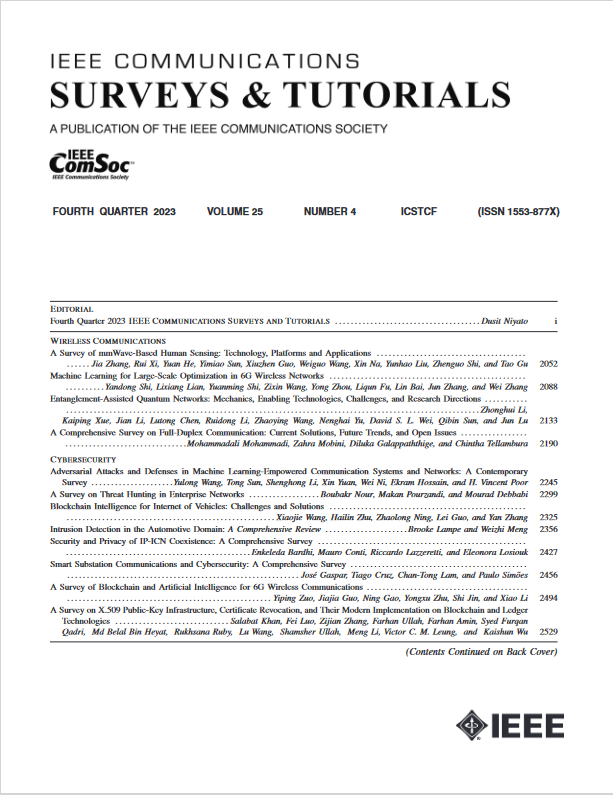Understanding Wireless Charger Networks: Concepts, Current Research, and Future Directions
IF 34.4
1区 计算机科学
Q1 COMPUTER SCIENCE, INFORMATION SYSTEMS
引用次数: 0
Abstract
Wireless Charger Network (WCN) emerges as a promising networking paradigm, employing wireless chargers with Wireless Power Transfer (WPT) technology to provide long-term and sustainable energy supply for future networks. Although extensive research has been conducted in this area over the last decade, there is currently no comprehensive survey to compile the latest literature and provide insights into future research directions. To fill this gap, our survey explores the recent developments in the active research area of WCNs. This paper starts by providing a framework of WCNs in detail, covering aspects of network architecture, various charging models, network design issues, and typical applications of WCNs. Then, we give an overview of charger deployment schemes, focusing on omnidirectional, directional, non-radiative, and heterogeneous charger deployments. We also provide an overview of charging scheduling schemes, encompassing power control, time allocation, energy beamforming, and multi-resource scheduling. Moreover, we explore communication optimization schemes, including Medium Access Control (MAC) protocols, routing protocols, broadcast transmission, and data collection. Finally, we highlight some future research directions and present corresponding open issues to advance the research on WCNs.了解无线充电器网络:概念、当前研究和未来方向
无线充电器网络(Wireless Charger Network, WCN)是一种极具发展前景的网络模式,它采用无线充电器和无线电力传输(Wireless Power Transfer, WPT)技术,为未来网络提供长期、可持续的能源供应。虽然在过去的十年中在这一领域进行了广泛的研究,但目前还没有全面的调查来汇编最新的文献并为未来的研究方向提供见解。为了填补这一空白,我们的调查探讨了WCNs活跃研究领域的最新发展。本文首先详细介绍了无线网络网络的框架,包括网络架构、各种收费模式、网络设计问题以及无线网络网络的典型应用。然后,我们概述了充电器部署方案,重点是全向,定向,非辐射和异构充电器部署。我们还概述了充电调度方案,包括功率控制、时间分配、能量波束形成和多资源调度。此外,我们还探讨了通信优化方案,包括介质访问控制(MAC)协议、路由协议、广播传输和数据收集。最后,对未来的研究方向进行了展望,并提出了相应的开放性问题,以促进WCNs的研究。
本文章由计算机程序翻译,如有差异,请以英文原文为准。
求助全文
约1分钟内获得全文
求助全文
来源期刊

IEEE Communications Surveys and Tutorials
COMPUTER SCIENCE, INFORMATION SYSTEMS-TELECOMMUNICATIONS
CiteScore
80.20
自引率
2.50%
发文量
84
审稿时长
6 months
期刊介绍:
IEEE Communications Surveys & Tutorials is an online journal published by the IEEE Communications Society for tutorials and surveys covering all aspects of the communications field. Telecommunications technology is progressing at a rapid pace, and the IEEE Communications Society is committed to providing researchers and other professionals the information and tools to stay abreast. IEEE Communications Surveys and Tutorials focuses on integrating and adding understanding to the existing literature on communications, putting results in context. Whether searching for in-depth information about a familiar area or an introduction into a new area, IEEE Communications Surveys & Tutorials aims to be the premier source of peer-reviewed, comprehensive tutorials and surveys, and pointers to further sources. IEEE Communications Surveys & Tutorials publishes only articles exclusively written for IEEE Communications Surveys & Tutorials and go through a rigorous review process before their publication in the quarterly issues.
A tutorial article in the IEEE Communications Surveys & Tutorials should be designed to help the reader to become familiar with and learn something specific about a chosen topic. In contrast, the term survey, as applied here, is defined to mean a survey of the literature. A survey article in IEEE Communications Surveys & Tutorials should provide a comprehensive review of developments in a selected area, covering its development from its inception to its current state and beyond, and illustrating its development through liberal citations from the literature. Both tutorials and surveys should be tutorial in nature and should be written in a style comprehensible to readers outside the specialty of the article.
 求助内容:
求助内容: 应助结果提醒方式:
应助结果提醒方式:


